June 1944 QST
 Table
of Contents Table
of Contents
Wax nostalgic about and learn from the history of early electronics. See articles
from
QST, published December 1915 - present (visit ARRL
for info). All copyrights hereby acknowledged.
|
"Necessity is the mother of invention"
is an oft-heard phrase that never rang truer than during World War II.
Both the Axis and the Allied powers had extremely brilliant and capable people
working to defeat each other, driving advances in technology and methods at
a break-neck pace for nearly a decade (remember WWII began before the U.S. entered
the fray in 1941). Aircraft and radio were powerful new weapons for all sides
at that point since both were still in their fledgling modes in WWI. Efficient
and effective execution of aircraft ferrying, troop movement, and supply delivery
was absolutely dependent on radio equipment and operators that could adapt to
new strategic situations and endure all sorts of weather and geographic stresses.
While the Army Signal Corps had a good cadre of radio operators available, few
were experienced with operating in their gear while airborne. Background noise
(audible and electronic) and vibration from the engines and airframe tested
the limits of skills. This article from the June 1944 edition of the ARRL's
QST magazine tells the story of one of the Army Air Corps' greatest wartime
successes. Take a good look at the photos; some guy or gal in one of them might
just be your parent or grandparent.
Flying Radiomen [and Radiowomen] of the Ferrying Division
Duties and Training of Flight Radio Operators of the Ferrying Division,
ATC, AAF
By Lt. Col. Howard J. Haines,* EX-W2EIS
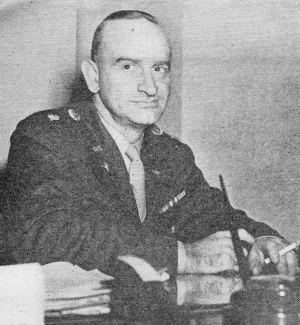
The author, ex-W2EIS, at his desk at Ferrying Division Headquarters
in Cincinnati. As director of radio training for the Ferrying Division he is
in charge of the Advanced Radio Training Unit.
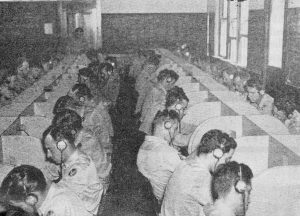
ARTU students get post-graduate training in code ...
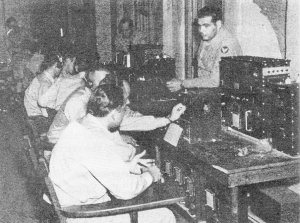
... and lab to qualify them for their specialized jobs.
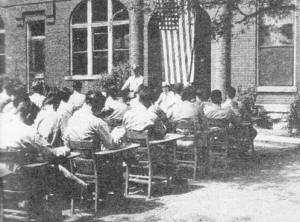
The 60·day course ends with graduation exercises ...
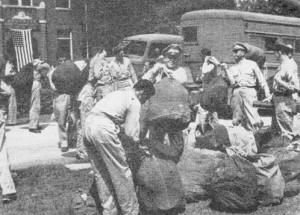
... and the class leaves for points all over the globe.
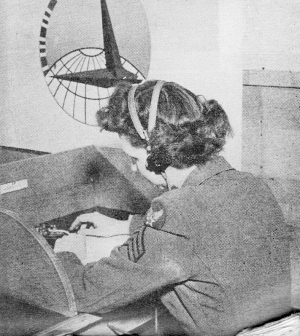
WAC code instructors help ARTU students to boost code speeds
and learn finer points of operating procedure. Here Sgt. Carol A. Briggs is
shown sending a practice transmission from a student's operating position on
a code-room practice table.
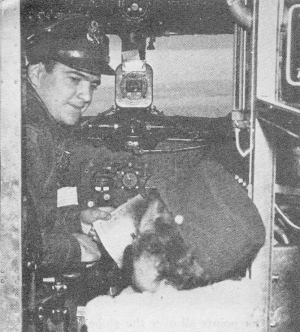
When the ARTU schools at Nashville and Long Beach were consolidated
at the Reno Air Base, the WAC code instructors from the Nashville school got
some actual experience as flight radio operators aboard the convoy of C-47
transports which transferred the personnel and equipment to the new school.
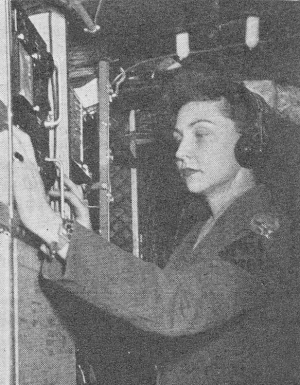
WAC operating radio in C-47
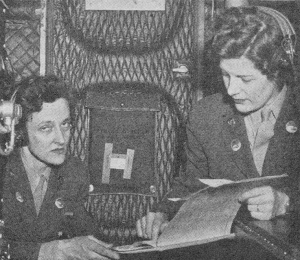
WAC training in Army Air Corps C-47
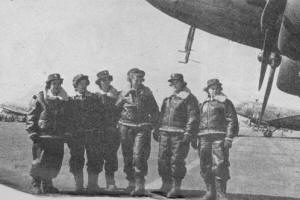
WAC group standing under nose of Douglas C-47 Skytrain (I'm
jealous - the C-47/DC-3 is my favorite twin prop airplane)
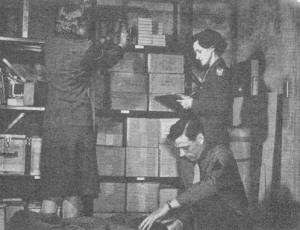
After the WAC radio instructors of the Ferrying Division
landed at the Reno Air Base (opposite page, below) they shed flying togs and
immediately went to work helping the male instructors get the school in operation.
Top to bottom - (1) Two WAC sergeants inventoried supplies.
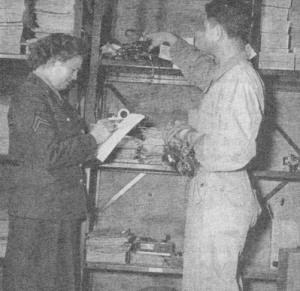
(2) A WAC corporal helped check lab equipment.
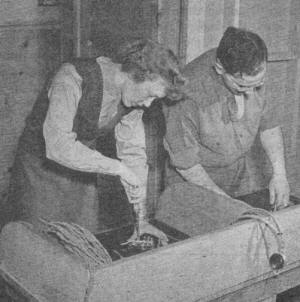
(3) Another sergeant and a male co-worker installed code-practice
tables.
All Official Ferrying Division Photos
This war has brought great strides in the development of aircraft radio communication
and navigation. The U. S. Army has great accomplishments to its credit in this
field, and not the least of these is the way thousands of men have been finely
trained to operate the new instruments. A notable example of such achievement
by Air Forces schools is the work of the Advanced Radio Training Unit of the
Ferrying Division, Air Transport Command.
To understand the work performed by this Unit it is necessary first to know
that the Ferrying Division of the Air Transport Command delivers to Army air
bases throughout the world most of the aircraft manufactured in the United States
for the AAF, and in addition handles the movement of aircraft manufactured for
lend-lease to the United Nations. Operations of the Division extend throughout
the world and include regularly scheduled transport service between Florida
and India over the longest such route in existence - a distance of 14,000 miles.
As background it may be noted that the Air Transport Command itself is an
outgrowth of the original Ferrying Command. Created in the summer of 1941, the
initial function of the Ferrying Command was that of delivering to Canadian
airports lend-lease aircraft being manufactured in this country for the British.
Shortly thereafter it was given the additional assignment of carrying diplomatic
mail and important personnel between the U. S. A. and the United Kingdom.
After U. S. entry into the war the functions of the Ferrying Command multiplied,
and in July, 1942, it was reorganized as the Air Transport Command. Eight separate
wings of the ATC now perform varied duties ranging from administering priorities
for air travel to flying vital cargoes of military freight to focal military
points all over the globe. The renamed Ferrying Division still performs its
original function of ferrying military aircraft, however.
Another major activity of the Division is conduct of most of the Air Transport
Command's training program. Advanced radio training is one of the important
phases of that program, as developed by Brig. Gen. William H. Tunner, commanding
general of the Ferrying Division - a graduate of West Point who, incidentally,
at the age of 37 holds a command pilot rating.
Flight Operators vs. Ground Operators
With the development of the stepped-up air program for World War II, it was
early discovered that a vast difference existed between the qualifications required
for ground radio operators and those for flight radio operators.
The Ferrying Division lost no time in correcting this difference by establishing
its own schools for the specific purpose of training ground radio operators
for duty in the air.
Men who can successfully pull signals out of the air while sitting on terra
firma require altogether different training if they are to be able to do the
same thing successfully while in flight. The physical requirements also are
different; the airborne operator must have the same physical characteristics
as the pilot and navigator.
Furthermore, the flight radio operator must know many things the ground operator
seldom hears about. One of the most important of these is radio navigation,
a facility which has saved the lives of many airmen in the past two years.
Prior to the war there had been little development of radio navigational
aids over the long routes across the oceans. Most overwater air travel was accomplished
in the traditional manner - by employing celestial navigation. But celestial
navigation, which is a function of the navigator, depends upon a good sight
of the stars, and such a sight cannot always be had in fog-bound areas such
as are common along the North Atlantic routes.
Fortunately, however, there had been developed good automatic direction finders
with which our larger planes were equipped, thereby enabling our radio operators
to establish their position by triangulation. Thus our flight radio operators
- apart from supplying radio communication - proved invaluable in providing
position reports which enabled the navigator to establish a compass course along
which the ship could fly to its destination.
A program for providing flight radio operators with the specialized training
required for their satisfactory performance of this and other duties was developed
by the Groups of the Ferrying Division located at nine major fields throughout
the United States. It was from these fields that aircraft left the continental
United States to fly overseas to the combat areas.
To satisfy the heavy demand for qualified flight radio operators two major
schools were established - one at Nashville, Tenn., and the other at Long Beach,
Calif. At these schools a 60-day advanced course - given under the direction
.of prominent former amateurs - quickly produced some of the finest flight radio
operators in the world.
The demand for these especially trained men continued to grow, and recently
the Nashville and Long Beach schools of the Advanced Training Unit were combined
in the one large school located at the Reno Army Air Base in Nevada. At this
school the student completes a 30-day ground course and then spends fifty hours
in one of three especially equipped aircraft working out radio problems in the
air. Many improvements are constantly being added for the benefit of the students
and the 60-day course is a pleasant one.
Flight Duties
Upon completion of the advanced training course the student is assigned to
one of the eight Groups of the Ferrying Division. There he joins a flight crew
which may take him over all of the routes of the Air Transport Command throughout
the world.
The flight radio operator's duties begin when the plane leaves the field,
and from then on he keeps a constant radio watch until the wheels of the plane
touch the ground at one of the many far-flung. airfields of the ATC anywhere
on the globe. During the flight he will receive at regular intervals time checks
and weather reports for the information of the navigator and pilot. He will
depend upon the liaison transmitter, rated at 75 watts, to contact ground stations
over enormous distances. To aid the navigator he will take frequent bearings
on radio stations which serve as a double check on the plane's position as plotted
by the navigator.
The traditional ingenuity attributed to radio amateurs was aptly illustrated
in the early days of the war by one flight-radio operator - a former ham - who
used his head to save a valuable airplane and its crew. He was aboard a four-engine
bomber approaching the West Coast across the Pacific. For some reason or other
the electrical system on the bomber had cut out. At the time the Pacific Coast
was in a highly alerted state, and detecting apparatus at scores of ground installations
soon picked up the drone from the motors of the big ship. But the aircraft remained
unidentified; without power its radio transmitter, of course, was dead. Soon
the big plane was located by numerous searchlight batteries, and fighting planes
were ready to shoot it out of the air.
The situation was grim. There seemed to be no means of signaling their identity,
and the pilot gave up all hope of making a safe landing. Then the radio operator
remembered the emergency radio transmitter - the famous Gibson Girl, an emergency
hand-powered rig intended for use in rubber boats when down at sea. Quickly
assigning the flight engineer the job of cranking for all he was worth, the
flight radio operator tapped out their assigned identification signals. Only
his prompt action prevented the otherwise certain destruction of the plane and
its crew.
Hams in the ARTU
Hams dominate the radio training program of the Ferrying Division. Capt.
Richard T. Parks, ex-W5AB, communications officer at the Long Beach Base and
staff advisor to the present school at Reno, has held a variety of amateur calls.
While engaged as a pilot for Pan American Airways he used the call OA4G in Peru
and CE3EL in Chili. Capt. Hale P. Farris is a well-known 80-meter ham from Wilmington,
Delaware.
The instructing group at Reno includes many hams. For instance, T/Sgt. Seymour
Mackoff served in Army radio since 1939 in the air and with ground stations.
His experiences carried him to Panama, Trinidad, and British Guiana. He installed
GI radio equipment in a captured Italian Savoia-Marchetti transport in British
Guiana and flew it to the U. S. for exhibition purposes. S/Sgt. Mylus O. Sharpe
has spent three years with AAF radio, having been trained by the Hawaiian Air
Force. His experiences on missions into enemy territory brought him the DFC
and Air Medal with oak leaf cluster for Pacific duty. Sgt. Norman F. Miller,
holder of a Class A amateur license, owned station W3CRR, Allentown, Pa., from
1930 on. He worked at K5AF, Albrook Field, Canal Zone, as QSL manager and also
served with WFA at Albrook Field. Cpl. Ecles L. Gossert, jr., with a Class B
ham license had his own station W4FSQ, at Ft. Bragg, N. C. He also operated
at W4EZH and K5AY, in addition to Army stations WVL, WVN and WAR, and was a
chief operator at sea for a year. Pfc. Jacob S. Saperstein, W2IMN, of Newark,
N. J., holds a Class A ham license, has served as president of the Amateur Club
of Newark and is a member of the Bloomfield Radio Club. Pfc. Frank Colvert,
W4DOP, a ham since 1930, has a Class A amateur license. Before the war he worked
at WPTF, Raleigh, N. C.
The ARTU instructors are among the world's finest. Each is a qualified, experienced
radio operator in his own right and has been carefully chosen because of his
ability to impart his knowledge to the students.
ARTU Training
Every man who enters the ARTU is a graduate of a basic radio school and many
of the students have had previous experience on foreign flights. The ARTU, however,
goes into greater detail than do the basic schools and the operators learn the
latest developments in radio technique. Their errors are ironed out by the ARTU.
Radio navigation is taught so thoroughly that a graduate of ARTU is fully
capable of bringing a plane safely to a base on his own when called upon to
do so. In fact, one of the ARTU alumnus did that very thing on his graduation
trip. Flying under conditions which made celestial navigation impossible, the
radio operator took triangulation bearings on known radio stations and secured
a position reading. By making progressive readings the operator brought the
plane safely to its destination.
The training given at the school accents the importance of flight radio operation
and stresses upon the student the fact that his training there may mean the
difference between life and death at some future date.
The ARTU course is of six weeks duration with eight hours of daily classes,
six days a week. Only the most capable receive graduation certificates, and
"washouts" are not uncommon. The reason for a student's washing out may be either
academic or physical.
ARTU classrooms are not confined to mere blackboards and charts. Every classroom
is fully equipped with a variety of radio instruments in sufficient numbers
to allow each student the opportunity to obtain ample practice and gain necessary
experience.
The course includes classes in the detailed pro-cedure of Air Transport Command
routes. Call signs and safest methods of entry are taught, for such familiarity
with routes and codes may prevent serious blundering upon future occasions in
actual flight.
In the code room higher operating speeds are attained and sending practice
is emphasized. Men are divided into small groups to simulate actual networks
such as would be encountered along actual Air Transport Command routes. A microphone
on each desk enables the student to practice the voice procedure used when working
with radio towers and the like.
At the present time there are a number of WACs among the code instructors.
It is interesting to note that the WACs find little difficulty in learning c.w.
and they have been an inspiration to the boys at the school - who marvel at
their code speed.
The equipment laboratory is supplied with transmitters identical to those
used in planes. These long-range transmitters will reach half-way around the
world under proper conditions. Individual attention is given each operator,
and no more than three or four men are assigned to each unit.
All is not taught in the classroom at ARTU, and much emphasis is placed on
active training in the air. It is not unusual for a man to be called from class
to board a plane. On such a trip an instructor accompanies the student and is
thus able to determine the operator's ability in actual flight. Use of the rubber
raft and life-saving accessories are taught as one of the many incidental, yet
highly important, subjects at ARTU. The finished graduate is a thoroughly schooled
aircraft crewman as well as radio operator.
Graduates of the ARTU scatter to all parts of the globe and become integral
parts of the crews that deliver aircraft from the factory assembly lines to
the fighting fronts. ARTU trained men are among the world's finest flight radio
operators and of a quality that puts them on a par with the skilled pilots,
mechanics and others who make up . the huge Ferrying Division of the Air Transport
Command.
The operations of the Ferrying Division have demonstrated the necessity for
improved radio aids to aerial navigation. The development of radio navigation
has made overwater air travel a much simpler process than it was ten years ago.
No doubt many developments yet unthought of will come from the hands of our
radio operators doing their bit flying the overwater airways of the world in
the present war.
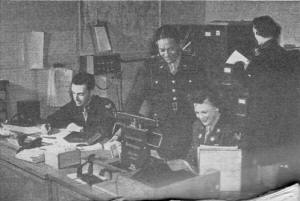
(4) ARTU administrative personnel moved into their new section.
* Division Communications Officer. Headquarters, Ferrying Division, 309 Vine
St , Cincinnati. Ohio.
Posted February 18, 2021
(updated from original post on 12/9/2012)
|























